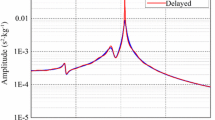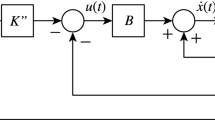Abstract
The purpose of this paper is to achieve an exhaustive and generalized method for the accurate calculation of the linear system settling time. Thus, the classical settling time expressions for the second-order linear systems are reviewed. Then, new expressions are proposed and developed for the step response of the second-order and for higher-order under-damped and over-damped linear systems. The proposed expressions are different from all the existing ones, and they are more accurate. In addition, iterative algorithms that can be easily implemented are proposed in order to achieve accurate calculation of the settling time. The accuracy of the new expressions and the proposed iterative algorithms are illustrated by several numerical simulation examples.











Similar content being viewed by others
References
W.H.T.M. Aangenent, W.P.M.H. Heemels, M.J.G. Van de Molengraft, D. Henrion, M. Steinbuch, Linear control of time domain constrained system. Automatica 48(5), 736–746 (2012)
H. Aminzadeh, M. Banihashemi, Miller compensation: optimal design for operational amplifiers with a required settling time. Circuits Syst. Signal Process. 33, 2675–2694 (2014)
H. Aminzadeh, M. Danaie, R. Lotfi, Design of high-speed two-stage cascode-compensated operational amplifiers based on settling time and open-loop parameters. Integr. VLSI 41, 183–192 (2008)
H. Aminzadeh, R. Lotfi, K. Mafinezhad, Design of low-power single-stage operational amplifiers based on an optimized settling model. Analog Integr. Circuits Signal Process. 58, 153–160 (2009)
H. Aminzadeh, Three-stage nested-Miller-compensated operational amplifiers: analysis, design, and optimization based on settling time. Int. J. Circuit Theory Appl. 39(6), 573–587 (2010)
C. Bert, An improved approximation for settling time of second order linear systems. IEEE Trans. Autom. Control 31(7), 642–643 (1986)
J.R. Carstens, Automatic control systems and components (Prentice Hall, New Jersey, 1990)
S. Cheng, Z. Zhangming, Y. Yintang, A fast-settling three-stage amplifier using regular Miller plus reversed indirect compensation. Circuits Syst. Signal Process. (2016). doi:10.1007/s00034-016-0314-7
V.N. Chetnov, Synthesis of a \(\text{ H }_{\infty }\)-controllers with given stability margin radius and settling time. Autom. Remote Control 75(2), 1593–1607 (2014)
L. Deng, P. Yang, Analysis of a general multi-capacity process standard form, in Chinese Control Conference (2015), pp. 332–337
R. Dorf, R. Bishop, Modern Control Systems (Prentice Hall, Englewood Cliffs, NJ, 2008)
J. Dorsey, Continuous and Discrete Control Systems: Modeling, Identification, Design and Implementation (McGraw-Hill, New York, 2002)
Y. Granjon, Automatique: systèmes linéaires, non linéaires, à temps continu, à temps discret, représentation d’état (Dunod, Paris, 2003)
R.C. Ionel, S. Ionel, A. Ignea, Calculation of the second order settling time in SISO linear systems. Circuits Syst. Signal Process. 32, 375–385 (2013)
M.V. Khlebnikov, Settling time in a linear dynamic system with bounded external disturbances. Autom. Remote Control 73(6), 937–948 (2012)
B.C. Kuo, F. Golnaraghi, Automatic Control Systems (Prentice Hall, Englewood Cliffs, NJ, 2002)
S. LeBallois, P. Codron, Automatique: systèmes linéaires et continus (Dunod, Paris, 2006)
A. Mandal, Introduction to Control Engineering (New Age, New Delhi, 2006)
A. Marques, Y. Geerts, M. Steyaert, W. Sansen, Settling time analysis of third order systems, in IEEE International Symposium of Circuits Systems (1998), pp. 505–508
N. Nise, Control Systems Engineering (Wiley, Hoboken, NJ, 2004)
J. Nocedal, S.J. Wright, Numerical Optimization (Springer, New York, 2006). ISBN 978-0-387-30303-1
K. Ogata, Modern Control Engineering (Prentice Hall, Englewood Cliffs, NJ, 2005)
R. Piché, Comments on “an improved approximation for settling time of second order linear systems”. IEEE Trans. Autom. Control 32(8), 747–748 (1987)
A. Pugliese, F. Amoroso, G. Cappuccino, G. Cocorullo, Settling-time-oriented design procedure for two-stage amplifiers with current-buffer Miller compensation. Rev. Roum. Sci. Tech. Electrotechn. Et Eng. 54(4), 375–384 (2009)
C.A. Ramos-Paja, D. González, A.J. Saavedra-Montes, Accurate calculation of settling time in second order systems: a photovoltaic application. Rev. Fac. Univ. Antioq. 66, 104–117 (2013)
Z. Zuo, Nonsingular fixed-time consensus tracking for second order multi-agent networks. Automatica 54, 305–309 (2015)
Acknowledgements
The author would like to address great thanks to Professor Mekki Ksouri for his encouragements and to all reviewers for their constructive comments.
Author information
Authors and Affiliations
Corresponding author
Rights and permissions
About this article
Cite this article
Chagra, W. Accurate Calculation of the Settling Time of a Linear System Using New Expressions and Iterative Algorithms. Circuits Syst Signal Process 37, 408–431 (2018). https://doi.org/10.1007/s00034-017-0560-3
Received:
Revised:
Accepted:
Published:
Issue Date:
DOI: https://doi.org/10.1007/s00034-017-0560-3




